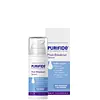What's inside
What's inside
 Key Ingredients
Key Ingredients

 Benefits
Benefits

 Concerns
Concerns

 Ingredients Side-by-side
Ingredients Side-by-side

Water
Skin ConditioningCoco-Caprylate/Caprate
EmollientNiacinamide
SmoothingCaprylic/Capric Triglyceride
MaskingGlycerin
HumectantPanthenol
Skin ConditioningXanthan Gum
EmulsifyingLysolecithin
EmulsifyingSclerotium Gum
Emulsion StabilisingBakuchiol
AntimicrobialHydroxyacetophenone
AntioxidantZinc Gluconate
Skin ConditioningPullulan
1,2-Hexanediol
Skin ConditioningCaprylyl Glycol
EmollientSodium Phytate
Silica
AbrasivePantolactone
HumectantCitric Acid
BufferingWater
Skin ConditioningGlycerin
HumectantCitric Acid
BufferingPolyacrylate Crosspolymer-11
Emulsion Stabilising1,2-Hexanediol
Skin ConditioningBakuchiol
AntimicrobialWithania Somnifera Root Extract
Skin ConditioningPassiflora Incarnata Fruit Extract
Skin ConditioningChamomilla Recutita Flower Extract
MaskingGalactoarabinan
Lactobacillus Ferment
Skin ConditioningRosa Damascena Extract
MaskingCucumis Sativus Fruit Extract
EmollientHydroxyacetophenone
AntioxidantDecyl Glucoside
CleansingMaltodextrin
AbsorbentCaprylyl/Capryl Glucoside
CleansingPolyglyceryl-10 Laurate
Skin ConditioningLauryl Glucoside
CleansingMica
Cosmetic ColorantPolyglyceryl-10 Oleate
Skin ConditioningXylitol
HumectantCaprylic Acid
CleansingCaprylyl Glycol
EmollientCI 77491
Cosmetic ColorantCI 77891
Cosmetic ColorantSilica
AbrasiveTin Oxide
AbrasiveCitronellol
PerfumingGeraniol
PerfumingWater, Glycerin, Citric Acid, Polyacrylate Crosspolymer-11, 1,2-Hexanediol, Bakuchiol, Withania Somnifera Root Extract, Passiflora Incarnata Fruit Extract, Chamomilla Recutita Flower Extract, Galactoarabinan, Lactobacillus Ferment, Rosa Damascena Extract, Cucumis Sativus Fruit Extract, Hydroxyacetophenone, Decyl Glucoside, Maltodextrin, Caprylyl/Capryl Glucoside, Polyglyceryl-10 Laurate, Lauryl Glucoside, Mica, Polyglyceryl-10 Oleate, Xylitol, Caprylic Acid, Caprylyl Glycol, CI 77491, CI 77891, Silica, Tin Oxide, Citronellol, Geraniol
 Reviews
Reviews

Ingredients Explained
These ingredients are found in both products.
Ingredients higher up in an ingredient list are typically present in a larger amount.
1,2-Hexanediol is a synthetic liquid and another multi-functional powerhouse.
It is a:
- Humectant, drawing moisture into the skin
- Emollient, helping to soften skin
- Solvent, dispersing and stabilizing formulas
- Preservative booster, enhancing the antimicrobial activity of other preservatives
Bakuchiol is a plant-derived antioxidant (it's vegan!). It is often called the replacement for retinol although it is not part of the same family.
It has similar effects as retinol: skin smoothing, reducing discoloration, and preventing wrinkles. It does not cause as much irritation as traditional retinoids.
Bakuchiol works by breaking down free radicals and stimulating collagen production in skin.
Combining bakuchiol with retinol will not have adverse side effects. Studies show using them will just boost the benefits. Bakuchiol is also found to help stabilize retinol.
While bakuchiol does not make the skin more sun sensitive, we recommend wearing SPF on a daily basis.
Read more about traditional retinol
Learn more about BakuchiolCaprylyl Glycol is a humectant and emollient, meaning it attracts and preserves moisture.
It is a common ingredient in many products, especially those designed to hydrate skin. The primary benefits are retaining moisture, skin softening, and promoting a healthy skin barrier.
Though Caprylyl Glycol is an alcohol derived from fatty acids, it is not the kind that can dry out skin.
This ingredient is also used as a preservative to extend the life of products. It has slight antimicrobial properties.
Learn more about Caprylyl GlycolCitric Acid is an alpha hydroxy acid (AHA) naturally found in citrus fruits like oranges, lemons, and limes.
Like other AHAs, citric acid can exfoliate skin by breaking down the bonds that hold dead skin cells together. This helps reveal smoother and brighter skin underneath.
However, this exfoliating effect only happens at high concentrations (20%) which can be hard to find in cosmetic products.
Due to this, citric acid is usually included in small amounts as a pH adjuster. This helps keep products slightly more acidic and compatible with skin's natural pH.
In skincare formulas, citric acid can:
While it can provide some skin benefits, research shows lactic acid and glycolic acid are generally more effective and less irritating exfoliants.
Most citric acid used in skincare today is made by fermenting sugars (usually from molasses). This synthetic version is identical to the natural citrus form but easier to stabilize and use in formulations.
Read more about some other popular AHA's here:
Learn more about Citric AcidGlycerin is already naturally found in your skin. It helps moisturize and protect your skin.
A study from 2016 found glycerin to be more effective as a humectant than AHAs and hyaluronic acid.
As a humectant, it helps the skin stay hydrated by pulling moisture to your skin. The low molecular weight of glycerin allows it to pull moisture into the deeper layers of your skin.
Hydrated skin improves your skin barrier; Your skin barrier helps protect against irritants and bacteria.
Glycerin has also been found to have antimicrobial and antiviral properties. Due to these properties, glycerin is often used in wound and burn treatments.
In cosmetics, glycerin is usually derived from plants such as soybean or palm. However, it can also be sourced from animals, such as tallow or animal fat.
This ingredient is organic, colorless, odorless, and non-toxic.
Glycerin is the name for this ingredient in American English. British English uses Glycerol/Glycerine.
Learn more about GlycerinHydroxyacetophenone is antioxidant with skin conditioning and soothing properties. It also boosts the efficiency of preservatives.
This ingredient is not irritating or sensitizing.
Silica, also known as silicon dioxide, is a naturally occurring mineral. It is used as a fine, spherical, and porous powder in cosmetics.
Though it has exfoliant properties, the function of silica varies depending on the product.
The unique structure of silica enhances the spreadability and adds smoothness, making it a great texture enhancer.
It is also used as an active carrier, emulsifier, and mattifier due to its ability to absorb excess oil.
In some products, tiny microneedles called spicules are made from silica or hydrolyzed sponge. When you rub them in, they lightly polish away dead skin layers and enhance the penetration of active ingredients.
Learn more about SilicaWater. It's the most common cosmetic ingredient of all. You'll usually see it at the top of ingredient lists, meaning that it makes up the largest part of the product.
So why is it so popular? Water most often acts as a solvent - this means that it helps dissolve other ingredients into the formulation.
You'll also recognize water as that liquid we all need to stay alive. If you see this, drink a glass of water. Stay hydrated!
Learn more about Water